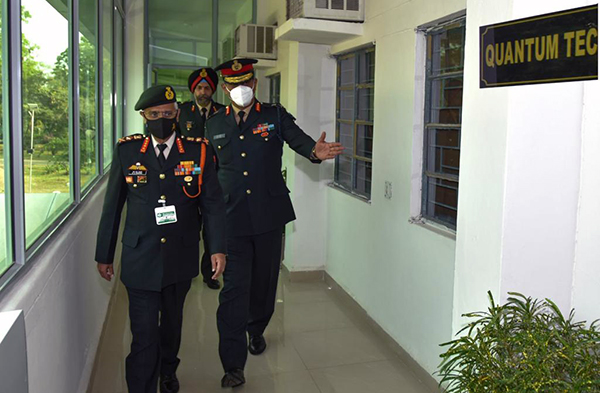Quantum Lab and AI Lab Set Up
The Indian Army is making steady, yet significant strides in the field of emerging technology domains.
Quantum Lab
The Army, has established the Quantum Lab at Military College of Telecommunication Engineering (MCTE), with support from the National Security Council Secretariat (NSCS) to spearhead research and training in this key developing field. Research undertaken by the Indian Army in the field of Quantum Technology will help leapfrog into next-generation communication and transform the current system of cryptography in the Indian Armed Forces to Post Quantum Cryptography (PQC). Key thrust areas are Quantum Key Distribution, Quantum Communication, Quantum Computing and Post Quantum Cryptography.
In October 2021, the ideation of Indian Army’s involvement in Electromagnetic (EM) Spectrum Operations had emerged at a seminar organised on EM Spectrum and National Security. Since then, Indian Army’s technology institutions have been encouraged to invest in AI, quantum and cyber domains.
Quantum key distribution, quantum computing, post quantum cryptography and quantum communication will be the key focus areas in the research. This research work is expected to transform the existing system of cryptography in the Indian armed forces to post quantum cryptography.
Artificial Intelligence Centre
The Army has several schemes underway on contemporary and emerging AI technologies. Apart from civil industry partnerships, an AI centre of excellence has been established at the Military College for Telecommunication Engineering in Mhow.
Application-oriented research in AI is also being conducted at two dedicated DRDO labs, Centre for Artificial Intelligence and Robotics (CAIR) and DRDO Young Scientist Laboratory (DYSL)-AI, both at Bengaluru. Moreover, all DRDO system labs have started AI technology groups to introduce AI features in all products.
But with countries like the US and China galloping towards AI-driven warfare, there is widespread acceptance that much more needs to be done on this “disruptive technology” front to boost the combat capability and survivability of Indian forces.
“Improved situational awareness, fusion of sensors, faster decision-making, use of autonomous weapons, and integration of AI into every facet of warfare, will necessitate changes to war fighting doctrines, organisations and structures, training methodology and leadership. For militaries across the world as well as for us, this remains an ongoing challenge, and a work in progress,” Army chief Gen MM Naravane said at a seminar.
Cyber Warfare
Training on cyber warfare is being imparted through a state of art cyber range, and cyber security labs.
By undertaking a multi-stakeholder approach incorporating Academia (such as IITs), DRDO organisations, Research Institutes, Corporate firms, Startups and Industry players, this initiative is an apt example of Civil-Military fusion with ”Atmanirbhar Bharat” a key driving factor. Requisite timelines based objectives with adequate funding have been worked out for projects and progressive fielding of solutions in the Indian Army is expected on a fast track basis. .
”Hackathon’ on Emerging Technologies
The Indian Army conducted a first-of-its-kind ‘Hackathon’, on 1 October 2021 to 31 December 2021, giving a shot in the arm for proficiency and expertise in the use of emerging technologies, and to delineate the technological side of the armed force. The hackathon was conducted in the MCTE, Mhow under the overall guidance of the Army Training Command (ARTRAC).
The event was conducted from under the name of “Sainya Ranakshetram”, in collaboration with the Rashtriya Raksha University. The virtual event witnessed the participation of over 15,000 participants and comprised a number of challenges based on secure coding, software defined radio exploitation and cyber offensive skills.
Further, the main highlights of the event included participants competing with each other in cyberspace against simulated threats. Additionally, the event also hosted a plethora of training sessions and sessions by experts for the participants. Cyber enthusiasts from across India were the cynosure in the entire event.
Messaging Application
The Indian Army, on 23 December, launched a new messaging application called Army Secure IndiGeneous Messaging Application (ASIGMA) for in-house communication. ASIGMA has been developed entirely in-house by a team of officers of the Corps of Signals.
The new application is being deployed on the Army’s internal network as a replacement of Army Wide Area Network (AWAN) messaging application which has been in service for the past 15 years. ASIGMA has been fielded on Army-owned hardware and lends itself to lifetime support with future upgrades, it said.
The bespoke messaging application meets all futuristic user requirements and boasts of an enhanced user experience. It has a variety of contemporary features, including multi-level security, message prioritisation and tracking, dynamic global address book and various options to meet the Army’s requirements.
This future ready messaging application will meet real time data transfer and messaging requirements of the Army, especially in the backdrop of current geo political security environment and is in line with the government of India’s Make in India initiative.
The Indian Army has braced automation in a major way, especially after the COVID-19 outbreak, and is taking substantial steps towards paperless functioning.


















